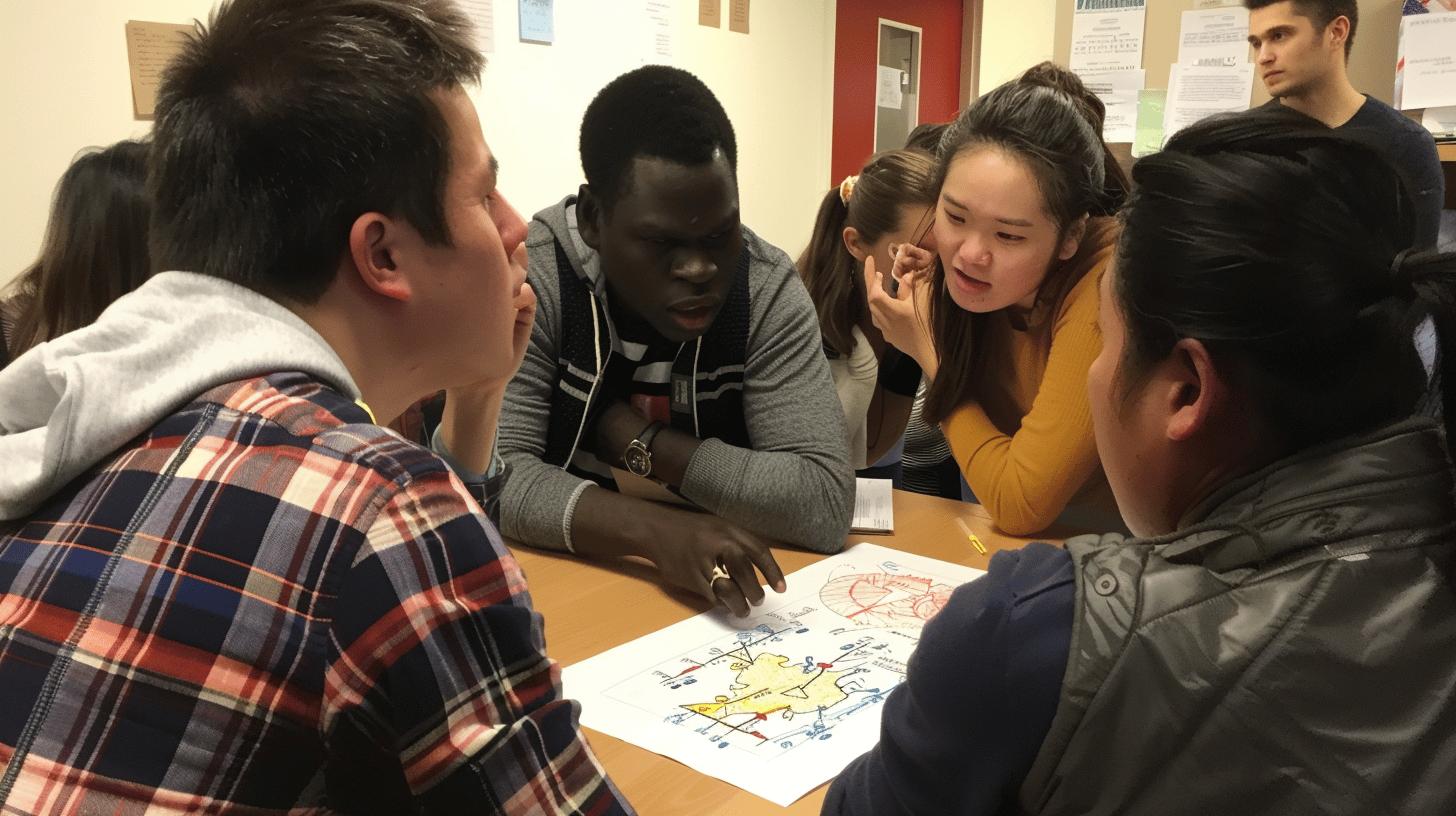How does our sense of identity evolve over time? Understanding identity development is not just a topic for psychologists—it's crucial for anyone navigating life's stages. This article explores key identity development models, offering insights into how personal identity is formed. From Erikson's stages of psychosocial development to Marcia's identity status theory and Cross's racial identity model, each framework provides valuable perspectives on the journey of self-discovery. Dive in to learn why these models matter and how they influence both individual and collective growth.
Overview of Identity Development Models
Identity development models are frameworks that explain how personal identity forms and evolves over time. These models are crucial for understanding identity development in psychology. They provide insight into the processes and stages through which individuals develop their sense of self. Understanding these models helps psychologists, educators, and counselors to support individuals effectively throughout various life stages.
Theories of identity development offer unique perspectives on the formation of identity. For example, Erikson's stages of psychosocial development highlight the importance of resolving conflicts at different life stages. Marcia's identity status theory categorizes individuals based on their exploration and commitment to identity. Cross's model of racial identity development focuses specifically on the transformation processes in Black identity. These models collectively provide a comprehensive view of identity formation and the factors influencing it.
- Erikson's Stages of Psychosocial Development
- Marcia's Identity Status Theory
- Cross's Model of Racial Identity Development
- Phinney’s Model of Ethnic Identity Development
- Kohlberg's Cognitive Developmental Theory
Recognizing the relevance of these models is essential for practical applications. In counseling, they guide therapists in addressing identity crises and promoting positive identity formation. In education, they help teachers create inclusive environments that support self-exploration. By understanding these models, professionals can better foster healthy identity development across diverse populations.
Erikson's Stages of Psychosocial Development

Erikson's stages of psychosocial development are a cornerstone in understanding identity development theories. His model consists of eight distinct stages, spanning from infancy to late adulthood, each marked by a specific conflict that must be resolved. Successful resolution of these conflicts leads to healthy identity development, whereas failure results in a weaker sense of self.
Trust vs. Mistrust
The first stage, Trust vs. Mistrust, occurs from birth to approximately 18 months. At this stage, infants depend on caregivers for stability and consistency of care. If caregivers provide reliable care and affection, the infant develops a sense of trust. Conversely, if care is inconsistent, the infant may develop mistrust.
Autonomy vs. Shame
The second stage, Autonomy vs. Shame, takes place between 18 months and 3 years. Here, children start to assert their independence. Encouragement and support from caregivers enable children to develop autonomy. Over-criticism or excessive control can lead to feelings of shame and doubt in their abilities.
Initiative vs. Guilt
Initiative vs. Guilt is the third stage, happening between 3 and 5 years. Children in this stage begin to plan activities, make up games, and initiate activities with others. If given the opportunity, they develop initiative. If not, they may develop guilt over their needs and desires.
Industry vs. Inferiority
The fourth stage, Industry vs. Inferiority, occurs between ages 5 and 12. At this stage, children start school and are exposed to new social and academic demands. Success leads to a sense of industry, while failure results in feelings of inferiority.
Identity vs. Role Confusion
During adolescence (ages 12 to 18), the fifth stage, Identity vs. Role Confusion, becomes crucial. Teens explore different roles and ideas to develop a personal identity. Successful resolution leads to a strong sense of self, while failure results in role confusion.
Intimacy vs. Isolation
The sixth stage, Intimacy vs. Isolation, spans young adulthood (ages 18 to 40). Individuals seek to form intimate relationships with others. Successful relationships result in strong connections, while failure leads to isolation and loneliness.
Generativity vs. Stagnation
Generativity vs. Stagnation is the seventh stage, occurring in middle adulthood (ages 40 to 65). Adults need to create or nurture things that will outlast them, often by parenting children or contributing to positive changes. Success leads to feelings of usefulness and accomplishment, while failure results in shallow involvement in the world.
Integrity vs. Despair
The final stage, Integrity vs. Despair, happens in late adulthood (ages 65 and older). Individuals reflect on their lives and either develop a sense of integrity if they are satisfied, or despair if they are not.
| Stage | Conflict | Description |
|---|---|---|
| Infancy | Trust vs. Mistrust | Developing trust when caregivers provide reliability, care, and affection |
| Early Childhood | Autonomy vs. Shame | Developing personal control and independence |
| Preschool | Initiative vs. Guilt | Beginning to assert control and power over the environment |
| School Age | Industry vs. Inferiority | Meeting social and academic demands |
| Adolescence | Identity vs. Role Confusion | Developing a personal identity |
| Young Adulthood | Intimacy vs. Isolation | Forming intimate, loving relationships |
| Middle Adulthood | Generativity vs. Stagnation | Creating or nurturing things that will outlast oneself |
| Late Adulthood | Integrity vs. Despair | Reflecting on life with a sense of fulfillment or regret |
Marcia's Identity Status Theory
Marcia's Identity Status Theory expands on Erikson's work by categorizing identity development into four statuses. These statuses describe how individuals cope with identity crises and the process of exploring and committing to an identity. Unlike Erikson's linear stages, Marcia's theory allows for movement between statuses, reflecting the dynamic nature of identity development.
Marcia's four identity statuses are Identity Diffusion, Identity Foreclosure, Identity Moratorium, and Identity Achievement. Identity Diffusion occurs when individuals have neither explored nor committed to any identities. Identity Foreclosure happens when individuals commit to an identity without exploration, often influenced by external factors like family expectations. Identity Moratorium is a phase of active exploration without commitment, where individuals seek out different roles and values. Finally, Identity Achievement is reached when individuals have explored and committed to an identity, resulting in a strong sense of self.
- Identity Diffusion
- Identity Foreclosure
- Identity Moratorium
- Identity Achievement
Practical examples illustrate these statuses clearly. A teenager in Identity Diffusion may lack direction and show little interest in future plans. Someone in Identity Foreclosure might follow a family business without considering other career options. A college student in Identity Moratorium might switch majors multiple times, exploring different fields. Lastly, an adult in Identity Achievement has solidified career and personal goals after thorough exploration.
Cross's Model of Racial Identity Development

Cross's Model of Racial Identity Development, also known as the Nigrescence model, is a seminal framework that outlines the transformation process Black individuals undergo as they develop a strong racial identity. Initially introduced in 1971 and revised in 1991, this model emphasizes the psychological and social changes that occur during racial identity formation. The model consists of five distinct stages: Pre-Encounter, Encounter, Immersion-Emersion, Internalization, and Internalization-Commitment. Each stage represents a different phase in the journey towards a fully realized Black identity.
Pre-Encounter
The Pre-Encounter stage is characterized by an individual's assimilation into the dominant culture and a lack of awareness or denial of their own racial identity. During this stage, individuals may adopt attitudes and behaviors that are congruent with the majority culture, often devaluing their own racial background. This stage is marked by a preference for the dominant culture's norms and a tendency to distance oneself from the Black community.
Encounter
The Encounter stage is triggered by a significant event or series of events that challenge an individual's perception of their racial identity. This experience often leads to a heightened awareness of racism and the realization that their previous worldview was incomplete or flawed. The Encounter stage prompts individuals to question their previous beliefs and attitudes, creating a sense of dissonance and a desire to explore their racial identity more deeply.
Immersion-Emersion
In the Immersion-Emersion stage, individuals immerse themselves in Black culture and actively reject the dominant culture. This stage is marked by a strong emotional response and a desire to connect with other Black individuals and communities. The immersion phase is characterized by an intense exploration of Black history, culture, and social issues. As individuals move into the emersion phase, they begin to develop a more nuanced understanding of their racial identity, balancing their new insights with a realistic perspective.
Internalization
The Internalization stage is where individuals achieve a secure and positive racial identity. At this point, they have reconciled their personal and racial identities, leading to a sense of inner peace and stability. Individuals in this stage are comfortable with their racial identity and can navigate both Black and non-Black environments without conflict. This stage is marked by a deeper understanding of the complexities of race and a commitment to promoting racial equality.
Internalization-Commitment
The final stage, Internalization-Commitment, involves taking active steps to promote social justice and racial equality. Individuals in this stage use their secure racial identity as a foundation for advocacy and activism. They are committed to improving conditions for their community and work towards systemic change. This stage represents the culmination of the racial identity development process, where personal transformation leads to broader societal impact.
Phinney’s Model of Ethnic Identity Development
Phinney's model of ethnic identity development is a framework that outlines how individuals come to understand and embrace their ethnic backgrounds. This model is particularly focused on the developmental stages during adolescence, a critical period for identity formation. It offers a structured approach to understanding the complexities of ethnic identity, helping to explain how young people navigate their cultural backgrounds.
Phinney's model includes three stages: Unexamined Ethnic Identity, Ethnic Identity Search, and Achieved Ethnic Identity. In the Unexamined Ethnic Identity stage, individuals have not yet explored their ethnic background and often accept the attitudes and beliefs of the dominant culture. The Ethnic Identity Search stage is marked by a heightened awareness and exploration of one's ethnic background, often triggered by experiences of discrimination or cultural awakening. The Achieved Ethnic Identity stage occurs when individuals have fully explored and accepted their ethnic background, leading to a secure and positive sense of ethnic identity.
- Unexamined Ethnic Identity
- Ethnic Identity Search
- Achieved Ethnic Identity
The relevance of Phinney's model in educational and social contexts is profound. In schools, educators can use this model to support students in understanding and valuing their ethnic backgrounds, fostering an inclusive environment. Socially, this model helps communities to develop programs that promote ethnic identity exploration and acceptance, thereby enhancing social cohesion and reducing ethnic tensions. Understanding these stages allows for targeted interventions that support positive ethnic identity development.
Gender Identity Development Models

Gender identity development models explain how individuals come to understand and identify with a particular gender. These models are essential for understanding the complexities of gender identity and the various factors that influence it. They highlight the role of socialization, cognitive processes, and cultural influences in shaping one's gender identity.
Kohlberg's Cognitive Developmental Theory and Bem’s Gender Schema Theory are two key theories in this field. Kohlberg's theory posits that children actively construct their gender identity through a series of stages, beginning with basic gender labeling and progressing to gender stability and consistency. Bem's Gender Schema Theory, on the other hand, emphasizes the role of cultural and societal norms in shaping gender identity. According to Bem, individuals internalize gender schemas from their environment, which then guide their behavior and perceptions.
Understanding these models is crucial for appreciating the nuances of transgender identity development. Both theories offer insights into how transgender individuals navigate their gender identity in a society that often imposes rigid gender norms. By recognizing the cognitive and cultural factors at play, professionals can better support transgender individuals in their journey toward a secure and authentic gender identity.
Practical Applications of Identity Development Models
Identity development models are not just theoretical frameworks; they have significant practical applications that can enhance various professional practices. By understanding these models, counselors, educators, and social workers can better support individuals in navigating their identity development journeys. These models provide valuable insights into the developmental stages and challenges that individuals face, enabling professionals to offer more tailored and effective interventions.
In counseling, identity development models are essential tools for addressing clients' identity struggles. Therapists can use these models to help clients understand their experiences and the underlying causes of their identity crises. For instance, Erikson's stages of psychosocial development can guide therapists in identifying specific conflicts clients may be facing at different life stages, such as Identity vs. Role Confusion during adolescence. By pinpointing these conflicts, therapists can develop targeted strategies to promote positive identity formation and resolve crises.
Educational settings also benefit greatly from the application of identity development models. Teachers and school counselors can use these models to create inclusive environments that support students' identity exploration and self-understanding. For example, incorporating activities that encourage self-reflection and cultural awareness can help students navigate Erikson's stages or Phinney's model of ethnic identity development. By fostering a supportive atmosphere, educators can aid students in achieving a secure sense of identity, which is crucial for their overall development and academic success.
- Encourage self-reflection activities
- Create culturally inclusive curriculums
- Provide mentorship programs
- Facilitate group discussions on identity
- Offer resources for identity exploration
The importance of these practical applications cannot be overstated. Whether in counseling, education, or social work, understanding and utilizing identity development models can lead to more effective support and intervention strategies. These models help professionals address identity-related challenges comprehensively, promoting healthier and more positive identity development outcomes for individuals across various contexts.
Final Words
Exploring identity development models, from Erikson's stages of psychosocial development to Cross's racial identity model, reveals essential frameworks for understanding how personal identity forms and evolves over time. These models provide unique insights into different aspects of identity development, significant in psychology.
Identity development models have practical applications in counseling, education, and social work. They enable professionals to address identity issues more effectively, fostering healthy identity formation.
Understanding these models empowers individuals and professionals alike, promoting more inclusive and supportive environments. The knowledge gained can positively influence personal and social well-being.
FAQ
What is the model of identity development?
Identity development models are frameworks that explain how personal identity forms and evolves over time. These models highlight different stages and processes involved in identity formation.
What is Marcia's theory of identity development?
Marcia's theory categorizes identity development into four statuses: Identity Diffusion, Identity Foreclosure, Identity Moratorium, and Identity Achievement. These statuses describe how individuals cope with identity crises and explore identity commitments.
What is the model of minority identity development?
Minority identity development models describe the unique processes individuals from minority groups undergo to form their identities. These models often emphasize overcoming societal challenges and embracing one's heritage.
What is Poston's biracial identity development model?
Poston's model includes five stages: Personal Identity, Choice of Group Categorization, Enmeshment/Denial, Appreciation, and Integration. It focuses on the unique identity development process of biracial individuals.
What are examples of identity development models?
Examples include Erikson's stages of psychosocial development, Marcia's identity status theory, Cross's model of racial identity development, Phinney's model of ethnic identity development, and Poston's biracial identity development model.
What is Cross's (1991) Black racial identity development model?
Cross's model, also known as the Nigrescence model, outlines Black identity development through five stages: Pre-Encounter, Encounter, Immersion-Emersion, Internalization, and Internalization-Commitment.
What are the four stages of ethnic identity development?
The four stages typically referenced are Unexamined Ethnic Identity, Ethnic Identity Search, Ethnic Identity Commitment, and Ethnic Identity Achievement.
What are identity development models in psychology?
Identity development models in psychology describe the processes and stages through which individuals form their sense of self. These models are crucial for understanding behavior and personality in various contexts.
What are identity development models in counseling?
In counseling, identity development models are used to help clients understand their identity struggles, resolve conflicts, and promote positive identity formation. They guide interventions tailored to individual needs.
What are cultural identity development models?
Cultural identity development models explain how individuals come to understand and embrace their cultural heritage and background. These models are essential for fostering cultural awareness and sensitivity.
What are some practical applications of identity development models?
Identity development models are used in counseling, education, and social work to understand clients' identity issues, provide tailored interventions, support inclusive environments, and foster self-exploration.


